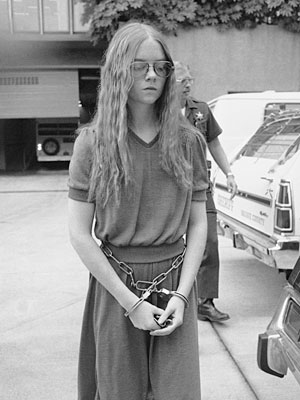“Ugh, it’s Monday” are the words that usually follow the arrival of the most dreaded day of the week. The sighs floating in the air are palpable and nothing seems possible. Mondays always carry with them a negative connotation and contain components such as depression, fatigue, and anguish. But to a San Diego elementary school, and to a troubled sixteen year old, Monday, January 29, 1979 held an even more distressing meaning.

Students at Grover Cleveland Elementary School, located in San Diego, California, began what they believed would be a normal Monday morning like any other, with bells ringing and students racing to their classes. Little did they know, however, that across the street, sixteen-year-old Brenda Ann Spencer was aiming her .22 caliber semiautomatic rifle right at society’s ultimate refuge, the elementary school, and its surroundings. After the first bell rang, Brenda broke the panels on the front door of her home, which was located right across the street from the elementary school. And she began to fire. The school’s principal, Burton Wragg, while rushing outside, was hit on the shoulder and chest with Spencer’s bullets and eventually died. Michael Suchar, the school’s custodian, ran outside with a blanket in order to cover Wragg and keep him from going into shock, but he quickly became the second victim of Spencer’s shooting and lost his life. In between all the chaos, 28 year old Robert Robb, a recent graduate of the police academy, while examining Wragg’s and Suchar’s bodies, was shot under his right shoulder blade.1 He would go on to survive though, along with the eight other children who were wounded in the incident. At least three of those children had abdominal wounds. A nine-year-old student, Cam Miller, was struck in the back with a bullet that exited through his chest without hitting any internal organs. Another, Christy Buell, was shot through her abdomen and in the buttocks, and had to undergo surgery in order to repair her intestine.2
When Gus Stevens, a reporter for the San Diego Evening Tribune, began calling around the area to gain more information about the shooting, he coincidentally placed a call to Spencer’s home where she gave him exactly what he wanted. She described the shooter, a sixteen year old, and the shooter’s address. When Stevens realized that she gave him her own address, he recognized what was going on and requested an interview while another staff member informed the police of the situation. The police, now aware of where the shots were coming from, were able evacuate the children and obstruct Spencer’s line of sight while trying to negotiate with her. After several hours, Brenda Spencer surrendered her weapon and several rounds of ammunition, and was subsequently arrested. While on the phone with Stevens, Spencer had stated that she was just shooting for the “fun of it.” She went on to say that she just didn’t like Mondays and did this “because it’s a way to cheer up the day.”3

Contrary to her initial claim, she later went on to state in her 2001 parole hearing that she had been “sexually abused by [her] father” and was “waiting for the cops to show up so they could shoot [her].”4 This new information has fueled many more theories today about Brenda Spencer’s true motives in committing such a crime. During her pretrial psychological testing, an injury to Spencer’s temporal lobe came to light. Spencer has also stated in a letter from prison that she experiences “grand mal seizures” that she has to counteract with medications.5 Such a brain injury would definitely be a precursor to epilepsy, which is two to four times more common among violent offenders than the public.6 The lack of treatment she received for this disease, to some, proves the neglect that she experienced from her family and in her childhood. Psychologist Jonathan Fast introduces the idea that her brain injury, abuse, and the effects of it pushed her to her final actions. He believes that the shame, ridicule, inferiority, and powerlessness that she felt encouraged her to go as far as she did. In another letter she wrote in prison, she stated that her “father had done everything a person could do to another person. The beatings, the touching, the emotional abuse.” She went on to state that no one, not teachers or counselors, gave her assistance through this, so she simply thought that this was how the world and how life worked. When her father gifted her the .22 caliber rifle, she thought that he was finally telling her to do it: to take her life successfully, unlike her past suicide attempts, and leave the world forever.7
Whether these theories are true or not, Brenda Spencer was tried as an adult and pleaded guilty to two counts of murder and nine counts of assault. She was sentenced to twenty-five years to life in prison, and is still serving her sentence at the California Institute for Women. The shooting has inspired a song by the Boomtown Rats called “I Don’t Like Mondays,” and has also gained other media coverage through a documentary.8 Her action went down in history as the first high profile school shooting and has become a vanguard to many future, unimaginable school situations and violent outbreaks. Whether Spencer was a cold-hearted killer or a truly lost and confused soul that simply wanted an escape, it is undeniable that her horrible actions have had some frightening consequences in our modern world.
- Jonathan Fast, Ceremonial Violence (New York: The Overlook Press, 2008), 25, 70-71. ↵
- Tamara Jones, “Look Back in Sorrow,” Good Housekeeping 227, no.5 (November 1998): 118. ↵
- Jonathan Fast, “Unforgiven and Alone: Brenda Spencer and Secret Shame,” in School Shootings: International Research, Case Studies, And Concepts For Prevention, ed. Nils Böckler (New York: Springer, 2013), 253-255. ↵
- Debra Sevey, “Subsequent Parole Consideration Hearing of Brenda Spencer,” (Capitol Electronic Reporting, 2001), 15-16. ↵
- Jennifer Furio, Letters From Prison: Voices Of Women Murderers (New York: Algora Pub., 2001), 134. ↵
- Jonathan Fast, ” Unforgiven and Alone: Brenda Spencer and Secret Shame,” in School Shootings: International Research, Case Studies, And Concepts For Prevention, ed. Nils Böckler (New York: Springer, 2013), 251. ↵
- Jennifer Furio, Letters From Prison: Voices Of Women Murderers (New York: Algora Pub., 2001), 134-135. ↵
- Encyclopedia of School Crime and Violence, September 2011, s.v. “Brenda Spencer,” by Laura L. Finley. ↵



243 comments
Alyssa Childs
When I started reading this article I thought it was just going to be another story of someone who was shooting up a school simply because they felt like it, and it is but it goes further than that. Although part of me, the emotional side, feels sorry for what this young girl went through, her actions were malicious and took the lives/injured innocent people. If only we could stop all the demented people in the world from injuring the young souls and turning them into something they weren’t born into. It saddens me to know that this isn’t the first time a school was shot up.
Vanessa Tombo
This article was very informative and surprising to me. A sixteen-year-old girl who shot at an Elementary school only because she did not like Mondays. This article does a great job in telling its readers that Brenda could have normalized the shooting she had done due to a brain injury and abuse she had endured through her earlier life.
Nathan Hudson
At the beginning of the article I thought I was going to read about a girl with a smug look on her face who killed kids because she hated Mondays, but during my read I was mistaken. This girl is an example of how painful experiences can push us to be destructive. I can only imagine the feeling of loneliness she felt in her life, but that does not excuse the murder and assault of innocent people. Great article
Robert Flores
Brenda Spencer was the first of her kind. Her mind was twisted because that is the way her world was. Her father was the true criminal who abused her until she did not want to live in the twisted world she was a part of. Maybe she thought she was doing those people a favor by relieving them of the world that she thought everybody lived in. It is a dark thought but I am just trying to figure out her true reasoning and point out that her father is the root cause of her evil.
Peter Coons
With school shootings as the norm these days, and for the most part, the response we get from our law makers is the “Thoughts and prayers” defense, this shows how far back this issue in our country goes. In fact, this is a statement more so on the problems the justice system faces with criminals with mental defects and past trauma, more so than gun laws since her weapon was given to her through the proper legal channels. An article that covers a case that I personally would have never read about.
Bryan Martin Patino
The article was quite interesting. It brought a bit of light to Brenda’s mind. It gave a before thought stone cold killer a bit of humanity and makes the reader feel some sort of sympathy for the abuse that she claims to have gone through. The article was well written and insight full to remind everyone that Monday is just not a good day, and that shootings like this could be prevented if the adults around the child could have stopped being idgits and realized that she was troubled and needed help even more so if she had a history of failed suicide attempts.
Yahaira Martinez
Reading this article made me realize how some people such as Brenda Spencer can commit these insane acts of crime and inflict pain against innocent souls such as these children and not even feel remorse about it and not know why. Whether its her being mentally ill, suffering from childhood trauma or an attempt to commit suicide, im truly in shock at Spencer’s selfish way of thinking and taking innocent lives just because she did not like mondays.
Lewis Wilson
From reading this article just gives me more evidence to my self and hopefully other readers that guns in the USA should be banned, because for a somebody as young as Brenda Spencer’s was committing a crime and the fashion she did is disgusting. I hope in the future and with all the resent and future events that follow with gun crime changes cause its absolutely disgusting, somebody at that age can have access to a gun.
Maricela Guerra
This woman is crazy, I don’t care if she just didn’t like Mondays or the fact that she was emotionally and physically abused but that does not give the right for anyone to do such a crime like this. I’m starting to see that more and more people go and do awful things to others, then go ahead and blame it on their “health issues” just because they don’t want to actually face the real consequences. There’s got to be a change in the system in order to convict those who murder.
Anna Guaderrama
I’m at a loss for words after reading this article. Although well written, informative, and insightful to what happened I still cannot fathom what must have gone through her mind to have committed such a disgusting act of hate. I mean, I’ve met a lot of people with some pretty messed up stories and psychological problems, myself included, but never could I see what kind of possible motives are behind the need to hurt others. I just find it utterly disgusting how anyone could even think of doing that.